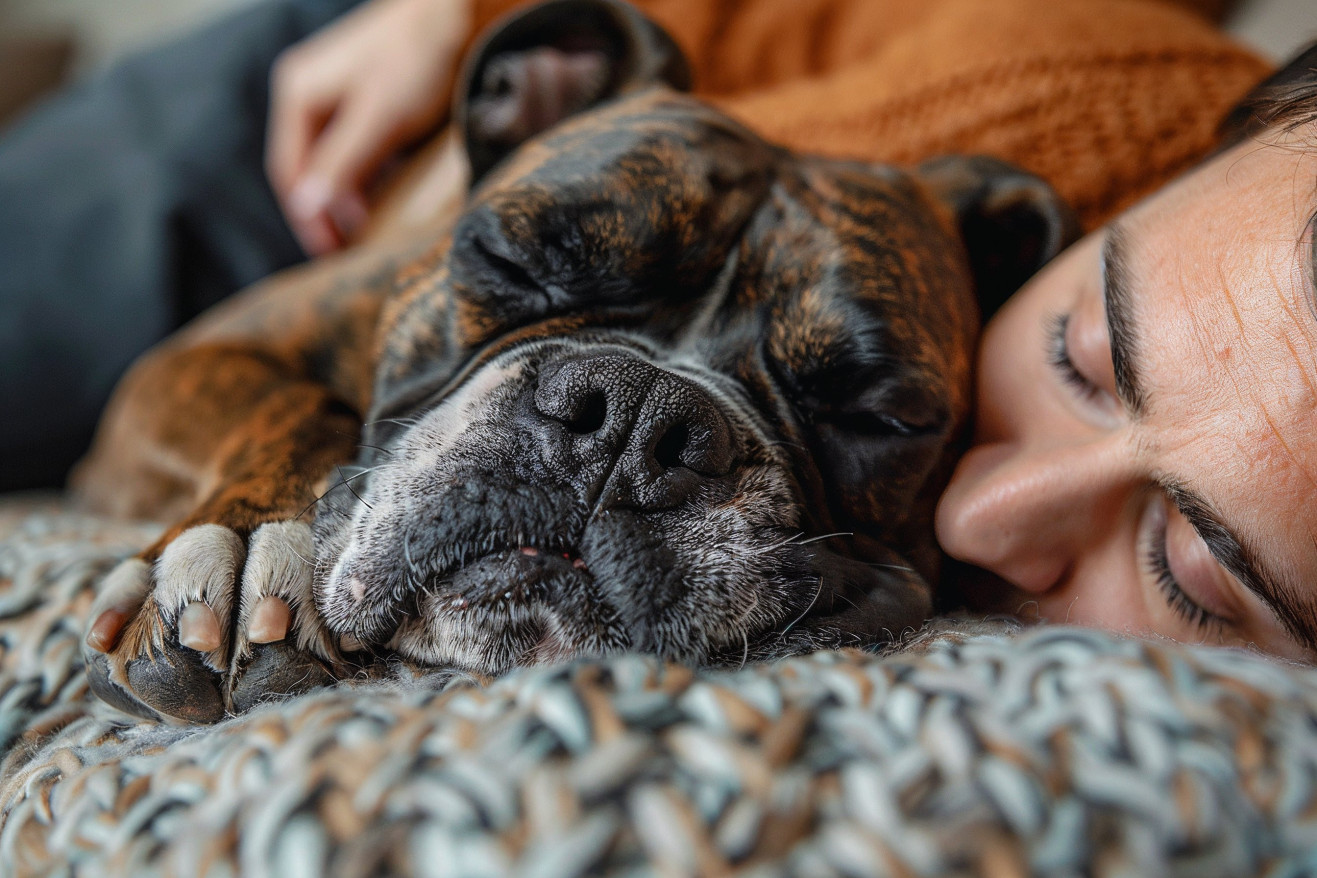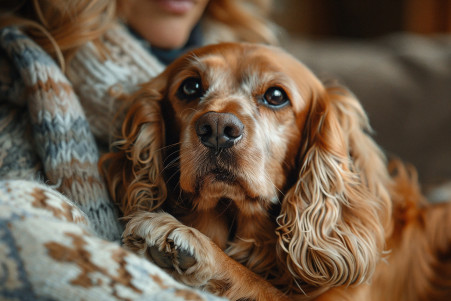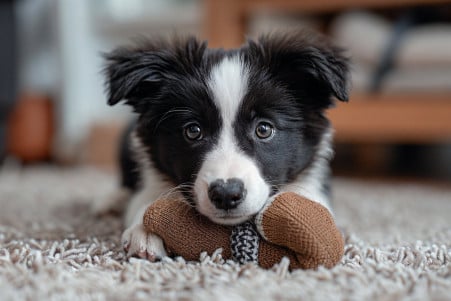What Causes Frito Feet in Dogs? The Science Behind the Smell
11 March 2024 • Updated 10 March 2024

If you’ve ever noticed that your dog’s paws smell like Fritos, you’re not alone. The bacteria Pseudomonas and Proteus that naturally live in the crevices of your dog’s paw pads are to blame for the Fritos-like scent. While the smell is generally harmless, it’s important to make sure that your dog’s paws don’t show any signs of infection.
In this article, we’ll take a deep dive into the science behind Frito Feet, looking at research in microbiology, veterinary science, and pet care. We’ll discuss the delicate balance of the canine skin microbiome and the external factors that contribute to this unique smell. We’ll also talk about the real-world implications for dog care and health to give you a full picture of how to best care for your dog’s paws.
What causes Frito feet in dogs?
Decoding the ‘Frito Feet’: Bacterial Bloom on Canine Paws
A range of microorganisms, including bacteria and yeast, colonize dogs’ paws. Of these, two bacteria, Pseudomonas and Proteus, are most often to blame for the ‘Frito Feet’ smell. Pupford notes that these bacteria, which are part of a dog’s natural skin microbiome, produce a chemical called putrescine that causes the corn chip odor.
The growth of these microorganisms is especially encouraged by warm, moist conditions. Dogs’ paws are the perfect place for bacteria to thrive because they sweat through their footpads, which creates an environment that’s moist and rich in natural oils. Oakhurst Veterinary Hospital adds that when dogs lick their paws, they make the situation worse by introducing oral bacteria to the mix.
While some of these bacteria are normal and necessary for a healthy skin microbiome, an overgrowth can be a sign of an infection. Inflammation, a foul smell, or a wound that doesn’t heal are all signs of a problem.
This fine line between a healthy level of bacteria and a potential infection is what drives the story of paw care in dogs, and it shows that these odors are more than just fun to sniff—they’re an important way to check in on our furry friends’ health.
The Science Behind Why Your Dog’s Paws Smell Like Fritos
The exceptional olfactory abilities of dogs, as noted in the scientific literature, are not only important for detection but also for the creation and maintenance of the odors on their paws. The dog’s body chemistry and the skin microbiome work together to create the smell. And a number of things, including genetics, age, and environmental factors, can all impact the unique smell of a dog’s paws.
The dog’s olfactory system, which includes the main olfactory epithelium and the vomeronasal organ, is involved in both the detection and emission of odors. This system, along with other physiological processes, is responsible for the specific ‘Frito’ smell that results when bacteria like Pseudomonas and Proteus interact with the sweat and oils on a dog’s paw pads.
Scent is a way that dogs naturally engage with their world and it’s a combination of cognitive and non-cognitive processes that are part of their smelling behavior.
As noted in Katarzyna Barłowska’s study, this is important because it’s essential to understand these olfactory processes to know when a smell is normal and when it might be a sign of an issue that requires attention to paw health and hygiene.
Grooming and Hygiene: How to Get Rid of the ‘Fritos’ Smell
Keeping your dog’s paws clean is key to minimizing the “Fritos” smell that so many dog owners experience. Regularly washing your dog’s paws with pet-safe shampoos and wipes can help reduce the bacteria and yeast that cause the smell.
Preventive Vet recommends products like the Dexas Mudbuster for a deep clean. You can also help by keeping your dog’s nails short and the hair between their toes trimmed, which will help keep dirt and moisture at bay and reduce the growth of bacteria and yeast.
The American Kennel Club recommends checking your dog’s paws regularly for any signs of injury or foreign objects that could cause irritation or infection. If you find any minor wounds, you can help reduce the risk of infection and the associated smell by cleaning them with an antibacterial solution.
You can also help keep your dog’s paws healthy and reduce the risk of the “Fritos” smell by using a dog-specific moisturizer like Pawmagik Paw Balm to keep their pads from drying out and cracking, which can lead to bacterial overgrowth.
Dog owners’ stories show that adding paw care to their regular grooming routine can help reduce the ‘Fritos’ smell, with many reporting a noticeable difference. By making these habits a regular part of your dog’s care, you can help reduce the smell and improve your dog’s overall foot health, setting the stage for a deeper dive into your dog’s skin microbiome.
The Microbial World of Dog Paws: The Microbiome and Odor
The skin microbiome of dogs is a complex community that is responsible for the distinct odors of dog paws, including the smell of corn chips. The skin microbiome is primarily composed of bacteria and fungi and is unique to each dog and can be impacted by a dog’s health.
A study in ScienceDirect explains that dogs with atopic dermatitis have a unique bacterial and fungal community, including an increase in Staphylococcus and a high presence of the fungus Blumeria, compared to dogs without the condition. This difference in the microbiome makeup is responsible for the differences in dog odors.
In addition, the community’s balance and diversity are important for the health of dogs and changes in them may be an indication of skin issues.
A study in Animal Microbiome explains that the microbiota is only found on the skin’s surface, with the deeper layers being sterile, which is where the interactions that produce odors take place. In addition, a study by Rodrigues Hoffmann et al. in PLOS ONE in 2023 found that allergic dogs have a lower species richness in their microbiome, which could impact the odors their skin produces.
The microbiome is also impacted by a dog’s breed, diet, and environment, which further impacts the odors that dogs produce. Understanding this complex community can help researchers and pet parents alike better understand how to keep dogs healthy and manage the odors that have become so familiar to those who love them.
The Takeaway on the ‘Frito Feet’ Phenomenon
On our quest to demystify the ‘Frito Feet’ phenomenon, we’ve delved into the microbiome of dogs’ paws and the role of natural bacteria like Pseudomonas and Proteus, as well as sweat and oils, in creating that familiar corn chip smell.
We’ve also learned that the strength of the odor can depend on a dog’s lifestyle, health, and even breed, with some breeds like Bulldogs and Pugs being more susceptible due to their skin folds, according to Pumpkin.
While the smell of Fritos coming from your dog’s paws is generally nothing to worry about, it’s important to make sure you’re keeping up with paw care to prevent bacterial or yeast overgrowth that can lead to infections. Vets like Dr. Linda Simon recommend regular grooming to help keep these smells in check and maintain a healthy environment for your dog’s paws, as Pumpkin points out.
In conclusion, it’s important to remember that the ‘Frito Feet’ smell is a natural and generally harmless part of your dog’s makeup. The experts at Oakhurst Veterinary Hospital stress the importance of paying attention to any changes in your dog’s paw odor.
Whether you find it endearing or it sends you running for the doggie wipes, the key is to strike a balance between enjoying this special part of dog ownership and making sure your pet’s paws are healthy. Lean into the experience, but always stay aware of what it means for your dog’s well-being.


